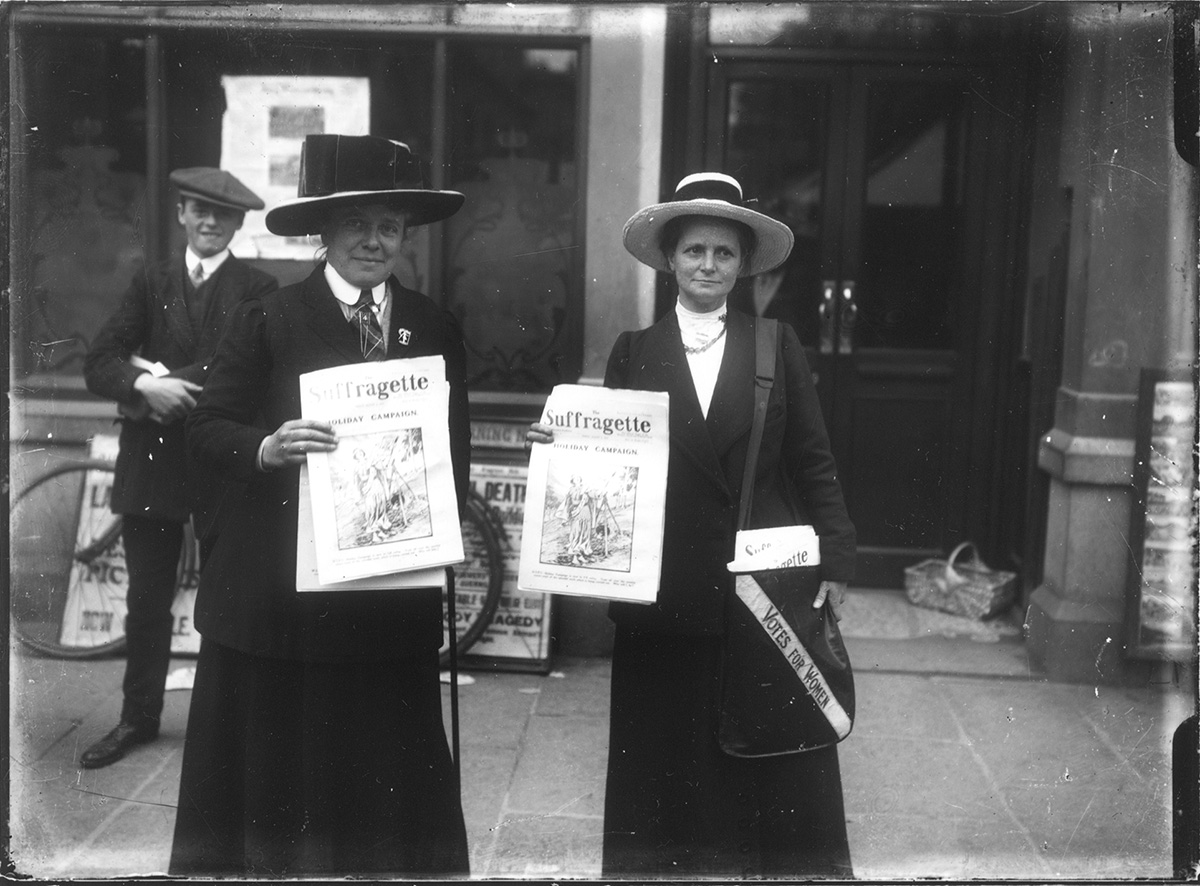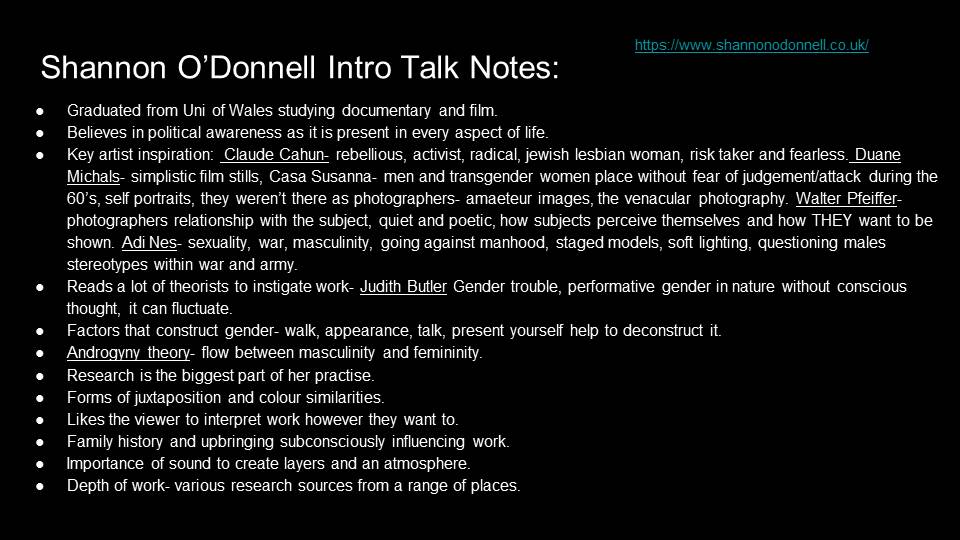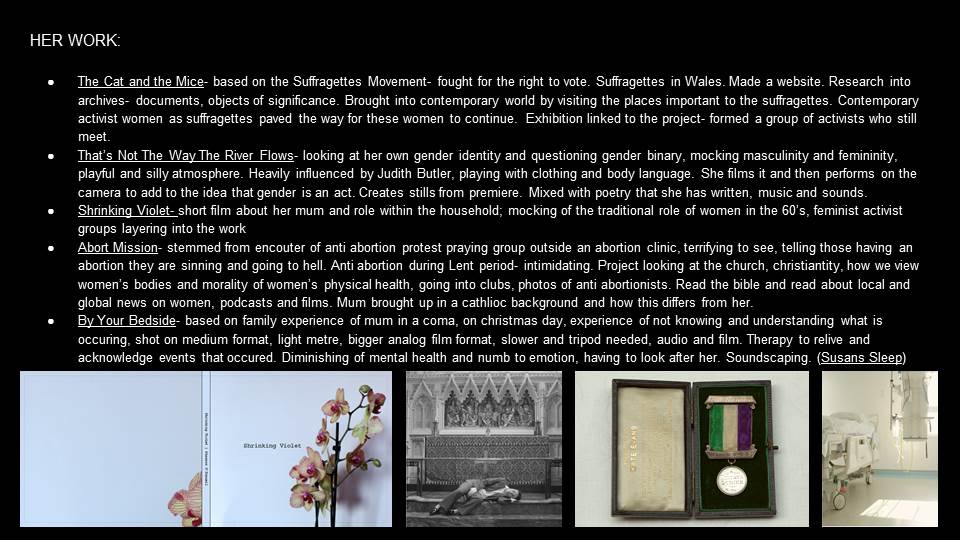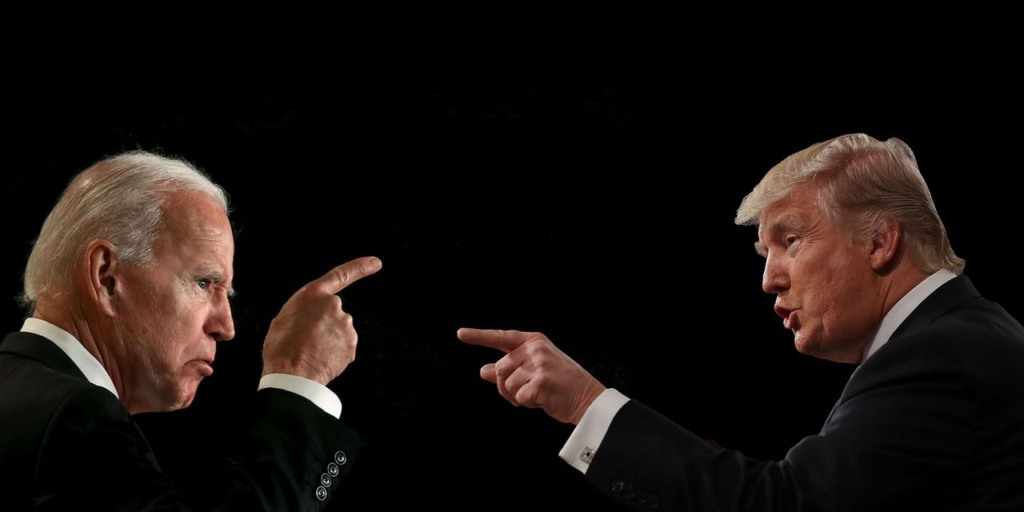Daily Archives: 14/10/2020
Filters
SHANNON O’DONNELL
- university of south wales
- inspirations; Claude Cahun , Duane Michals, casa Susanna, Adi
- politics local and global
- a level work was based o feminism
- ‘trying to not to manage relationship between opposites; its simply flowing between them’
- projects
- by your side (2018)
- cat and the mice (2018)
- not the way the river flows
- abort mission ( first university project)
- research work development
- videos
- films
- podcasts
- family history influences her work
- reading
- research
- likes forming things in colour
Protests + Movements
Suffragettes
The suffragette movement started began in the early 20th century around 1903 under the banner “Votes for Woman’. Unlike the similar movement of ‘Suffragists’ suffragettes believed in ‘Deeds not Words’. They had had enough and found that no one was listening so took protesting to extreme measures. This included being violent, putting bombs in letter boxes, chaining themselves to railings, smashing windows, getting arrested and going on hunger strikes in prisons. However, during the protests many suffragettes were attacked and sexually assaulted by policemen and other men.

#METOO – #NOWWHAT
Dadaism
Dada or Dadaism was an art movement from the culture of avant-garde in europe. Avant-garde was a group of people and works from around the 20th century who were revolutionary and experimental with art forms.
shannon o’donnell NOTES-
GENERAL NOTES-
historical context, deconstructing gender binary, gender theory, gender as a constructed concept, questioning authority roles and the roles of the oppressed classes/social groups from many different viewpoints, extensive theory work/research beforehand, current work in jersey in the archives, digitisation of film negatives and archival analogue images
INFLUENTIAL ARTISTS + THEORISTS-
Claude Cahun– politically motivated, often bends or swaps traditional gender roles, use of the abstract and surrealism, lived in Jersey during the Occupation but being Jewish Cahun was a target and was sentenced to death during the Occupation but this was never carried out, attempted to incite rebellion against the occupying forces with her partner Marcel Moore, very influential artist on the theme of gender, androgyny and self-identity, their main body of work is self-portraits
Duane Michals- innovative but simplistic work, black and white, uses photo-series and sequences to convey his messages, his photography has addressed some lgbtq+ issues, often incorporates text/handwriting alongside his images to add elements of emotional context and philosophy
Casa Susanna- found at a flea market in the early 2000s, this photo series was shot in the 60s by men and trans women while they were at a hotel/resort called Casa Susanna, run by a trans woman and her wife (Susanna and Marie Valenti), it was used as an escape to express their own identity without fear of judgement, intimate and private images,
Walter Pfeiffer- lgbtq+ issues, poeticism in imagery, features the subject taking back some control, subject was a young gay man
Adi Nes- features soldiers, links to the islraeli-palestine war, questioning of masculinity and traditional gender roles in society
Judith Butler- American philosophical theorist who focuses on gender as a social construct, personal identity, influenced fields of third-wave feminism, queer theory, literary theory as well as philosophy and ethics, speaks about how prescribed gender roles are passed down through generations and is more of a performance than anything else
June Singer- androgyny and gender theorist
O’DONNELL’S OWN WORK-
shrinking violet- Hautlieu A-level project, based on motherly roles in family and career, gently mocking women’s traditional roles during the 60s, 2nd wave feminism, domestic household setting
abort mission- project at uni, anti-abortion protesters vs pro-choice protesters, ideological beliefs and links to religion (specifically Christianity), the subjects were fully aware that they were being photographed, links to govmt and the justice system as well as the Church and sexuality/morality, controlling women’s bodies
by your bedside- relationship with her mother, she was in an induced coma due to breathing problems, links to family relationships, medical trauma + personal trauma, hospitalisation, personal impact, interviews with family members to gain outside first-hand viewpoints, art/photography as a form of therapy and closure, the film features the use of sound; layering music with interviews and background noise
cat and mice- in Cardiff, focuses on Suffragette movement in Wales, difference between suffragettes (militant activist) and the suffragists (political and pacifist), contextual links between the past and the present with reference to locations and the changes over time, historical police brutality
that’s not the way the river flows- gender identity, mocking the traditional concepts of femininity and masculinity, questioning the self and own self expression, short film, “moving still”, own poem and personal viewpoint on subject, questioning the binary of male and female, cutting stills from film camera, use of traditionally gendered clothing and manipulation of the expectations.
Art & Activism: Shannon O’Donnell presentation NOTES
- Studied documentary photography
- Claude Cahun is a big influence on Shannon
- Claude Cahun was a Jewish Lesbian woman
- A rebel and did thing she though was right
- Wore mens clothes in a lot of photos
- Also Influenced by Duane Michals
- displays images like a film real
- Casa Susanna
- A place where transgenders and LGBTQ people went where they could be free and not come under attach.
- Walter Pfeiffer
- Colaborates with subjects to document how the subject wants to be percieved
- Adi Nes
- Israeli Photographer
- Creates staged images of men breaking the ‘manhood’ stereotype
- ‘Questioning ‘Male Provado’ in the context of war.
- Key theorists:
- Judith Butler – “Masculine and feminine roles are not biologically fixed but socially constructed.”
- June Singer – “Androgyny is not trying to manage the relationship between the opposites; it is simply flowing between them.”
- ‘Shrinking Violet’ (2016) – One of Shannon’s projects
- Looking at feminism and her mom’s place in the house.
- ‘Abort Mission’ (2018) – First university project
- Started with an encounter anti abortion protestors
- Started thinking about woman’s health and how woman are viewed from society.
- Shannon read pretty much the whole bible
- Shannon likes to put juxtaposing images next to each other
- Forming sequences using colour, wide shots and tight shots
- ‘By Your Bedside’ (2018) – Personal project
- Her mum went into a coma
- Shot it on Medium format
- ‘The Cat and the Mice’ (2018) – University project
- Suffragette movement – militants
- Documented places that were key during the time
- Documented activist alive today
- Created a group of activists
- ‘That’s Not The Way the River Flow’ (2019)
- Heavily influenced by Judith Butler
- Lots of layers: Photos, videos, sound, poems
- Not taking yourself to seriously
Shannon O’DONNELL
- university of south wales
- politics (local / global)
- Claude Cahun
- Duane Michals
- Casa susanna
- Walter Pfieffer
- Adi Nes
- ‘Masculinities’ book
- The cat and the mice
- Suffragette movement
- Judith Butler
- Gender performativity
- That’s not the way the river flows
- poetry
Shannon O’Donnell Visit/ Feminism Notes
- Deconstructing Gender binary stereotypes
- Claude Cahun
- Duane Michals
- Casa Susanna
- Walter Pfleiffer
- Adi Nes – war – work on masculinity/ sexuality, book – masculinity
- Judith Butler – gender social construct
- Gendered roles don’t have to be followed
- Wales in relation with suffragette movement
- Suffragist Vs Suffragette
- the cat and the mice
- Dadaism
- That’s not the way the river flows – short film
Suffragists believed in peaceful, constitutional campaign methods. In the early 20th century, after the suffragists failed to make significant progress, a new generation of activists emerged. These women became known as the suffragettes, and they were willing to take direct, militant action for the cause.

A Dadaism was a movement with explicitly political overtones – a reaction to the senseless slaughter of the trenches of WWI. It essentially declared war against war, countering the absurdity of the establishment’s descent into chaos with its own kind of nonsense.
Sexism – Refers to the typical way in which men and women are taught to view each other as opposites, with the male being the more dominant/ superior gender.
Feminism – A range of social, political and ideological movements that aim to achieve equality in all fields for the sexes.
Patriarchy – A social system in which men hold most power and dominate in roles such as political leadership, moral authority, social privilege and control of property – a system where women are largely excluded.
Enfranchisement – The giving of a right or privilege, especially the right to vote.
Conservatism – Commitment to traditional values and ideas with opposition to change or innovation.
Neo-conservatism – Someone whose politics are conservative or right wing, who believes strongly in the free market and thinks that their country should use its military power to become involved with or try to control problems in other countries.
- Feminist = Political position
- Female = Matter of biology
- Feminine = Set of culturally defined characteristics
Key Theorists/ People
Mary Wollstonecraft (1792) – English writer and a passionate advocate of educational and social equality for women. She called for the betterment of women’s status through such political change as the radical reform of national educational systems. A Vindication of the Rights of Women .
Virginia Woolf (1929) – Argues that a woman needs financial freedom so as to be able to control her own space and life—to be unhindered by interruptions and sacrifices—in order to gain intellectual freedom and therefore be able to write independently (expressed through the title of her book – A room of one’s own).
Simone de Beauvoir (1949) – The Second Sex, discusses the treatment of women throughout history. Beauvoir researched and wrote the book in about 14 months between 1946 and 1949. The author also uses the comparison of girls being ‘treated like a live doll’, showing how they are totally submissive and only serve the purpose of looking pretty and being admired for that.
Jean Kilbourne – In the late 1960s, Jean Kilbourne began her exploration of the connection between advertising and several public health issues, including violence against women, eating disorders, and addiction, and launched a movement to promote media literacy as a way to prevent these problems. Critic of how women are depicted in advertising. made the documentary “Killing Us Softly”. began collecting ads with shaming or anti-feminist implications in the late 1960’s and things keep getting worse. Heavily critical of the use of women’s images in ads that teach women that looks are what matters most. most women feel ashamed and guilty when we fail. failure is inevitable because images are retouched, impossible for women of color to be perfect because only light-skinned woman achieve the ideal black women in ads are frequently featured in jungle settings and animal-skin-like clothing.
Laura Mulvey – Male Guise – The concept that texts present females through the eyes of a heterosexual male, often objectifying the physical form for gratification.
Judith Butler – According to Butler’s theory, gender is essentially a performative repetition of acts associated with male or female. Currently, the actions appropriate for men and women have been transmitted to produce a social atmosphere that both maintains and legitimizes a seemingly natural gender binary. For example, men must be masculine, they are expected to display attributes such as strength, power, and competitiveness, and less openly display emotion and affection (especially toward other men). Whereas women are forced to be conveyed as over-emotional, fragile and weak especially without a male partner. Judith Butler describes gender as ‘an identity instituted through a stylized repetition of acts’ meaning that as we grow our gender adapts and changes based upon representations we are presented with suggesting that gender is only a construct and should be viewed as something that is fluid.
Waves Of Feminism –
The First Wave Of Feminism – Occurred during the 19th and early 20th century throughout the Western world. It focused on legal issues, primarily on securing women’s right to vote, a key movement/ group would be the suffragette movement which occurred during this period.
The Second Wave Of Feminism – began in the United States in the early 1960s and lasted roughly two decades. It quickly spread across the Western world, with an aim to increase equality for women by gaining more than just enfranchisement.
The Third Waves Of Feminism – Influenced by the postmodernist movement in the academy, third-wave feminists sought to question, reclaim, and redefine the ideas, words, and media that have transmitted ideas about womanhood, gender, beauty, sexuality, femininity, and masculinity, among other things. Started in the US in the early 1990s and continued until the fourth wave which began in the 2010s.
Raunch Culture – Women and the Rise of Raunch Culture (2005) is a book by Ariel Levy which critiques the highly sexualized American culture in which women are objectified, objectify one another, and are encouraged to objectify themselves. Levy refers to this as “raunch culture.”
Art & ACTIVISM: Identity Politics + Culture Wars
Identity politics:

Identity politics is where social matters to do with people’s identity, usually including topics such as homosexuality, race, gender, death penalty, abortion, religion and more are discussed. Laws are created or changed to try and be more inclusive and tolerant of peoples beliefs.
Culture Wars:
Culture wars is the conflict between groups of people (cultures) who have different social views and beliefs. Often topics of culture wars include the government, race, gender, voting, and laws.
How does Culture Wars and Identity Politics impact society?
ZINE FULL PLAN
Shoots
Shoot 1 – Buildings/objects of significance
Shoot 2 – Archival photos/portraits
Shoot 3 – Portraits of family members in the present day (environmental and candid portraits)
Layout
Use bleed on good images that are high quality. The quality of the photos must be high throughout as the zine may be opened on any page, and thus interest for the reader/observer must be maintained throughout. Portraits of people will remain on the right side page, and the left reserved for an abstract object with no context, however has a special meaning ti the person photographed next to it, some form of significance to them which allows the reader to make assumptions and try and piece together clues and similarities and thus make sense of the story I am trying to tell.
SHOOT ONE
WHERE: Various Locations
WHO: I am going to photograph places/buildings of significance to my family ready for the zine. This will include previous places of residence for my grandparents. This shoot will be purely focused on places of significance, not portraits of people just yet, that will be reserved for my next shoot.
EQUIPMENT/ LIGHTING: Natural light as they will be predominantly outdoors. Natural light on a sunny day will allow for a more authentic look.
COMPOSITION: There will be multiple different angles

SHOOT TWO
WHERE: In a studio or well lit room
WHAT: Photos of old pictures/photographs or old places of residence and old portrait photos from archive/family albums
EQUIPMENT/ LIGHTING: Studio lighting and use of camera flash, holding camera on a tripod above the photo facing down to create an overhead shot. Hopefully no blurs or shine will show up in the photos taken as I want to maintain high resolution and detail focused all around the image.
COMPOSITION: Symmetrical, overhead shot made to fill the frame or with large, chunky white or coloured borders depending on the image.
SHOOT THREE
WHERE: At home or work, potentially could make a tableaux and create a story through a staged photo shoot, or candid photographs of him in the garden or garage working.
WHAT: Portrait photos of my dad both candid and environmental.
EQUIPMENT/ LIGHTING: Natural light as they will be predominantly outdoors. Natural light on a sunny day will allow for a more authentic look.
COMPOSITION: There will be multiple different angles and compositions as there will be many different things I will be photographing.





